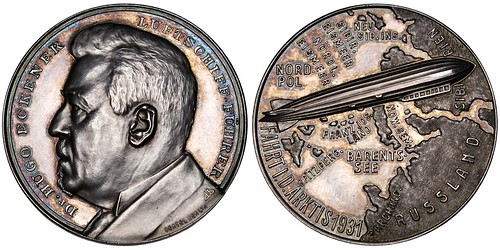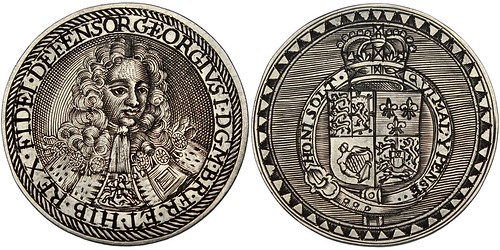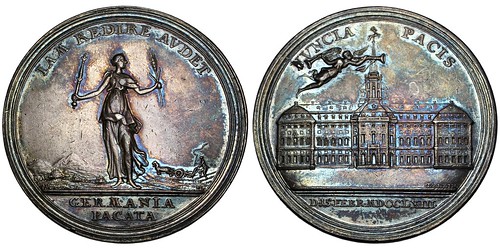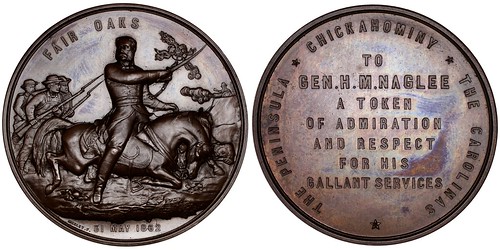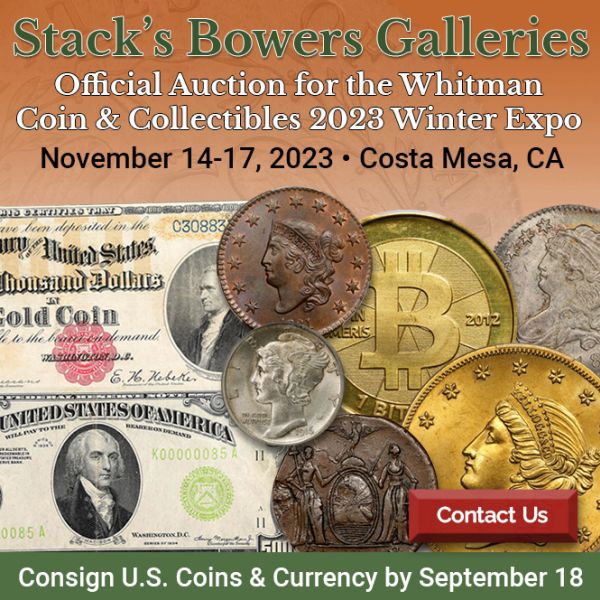
PREV ARTICLE
NEXT ARTICLE
FULL ISSUE
PREV FULL ISSUE
NUMISMAGRAM MEDAL SELECTIONS: SEPTEMBER 17, 2023Numismagram's Jeremy Bostwick forwarded these four medals from his most recent upload of new medals and tokens to his site. For all of the new material, please visit https://www.numismagram.com/inventory. -Editor 102278 | GERMANY & the ARCTIC CIRCLE. Polar Flight of the LZ 127 Graf Zeppelin silver Medal. Issued 1931. Commemorating the northern voyage of the airship from 24 to 31 July (35mm, 18.52 g, 12h). By O. Oertel in Berlin. Dr HUGO ECKENER LUFTSCHIFF-FÜHRER, bust of Eckener left // FAHRT I. D. ARKTIS 1931, airship flying right, with the place names of various place names referenced: North Pole, Arctic Ocean, Laptev Sea, New Siberian Islands, Siberia, Russla, Novaya Zemlya, Franz Josef Land, Barents Sea, Arkhangelsk, and Spitzberg (Svalbard). Edge: SILBER 990. Hans Kaiser 576; Button 279; Joos a.697. PCGS SP-63. Subtle matte nature to the devices, with great brilliance in the fields, along with some alluring toning that deepens nearer the peripheries. A very rare and seldom encountered Zeppelin medal with a cartographic crossover appeal. Even when encountered, a type that is often seen with cleaning and/or other defects. $985. Zeppelin was a German general and aircraft manufacturer, who later founded the airship company Luftschiffbau Zeppelin. Following Zeppelin's death in 1917, Dr. Hugo Eckener became the head of this company and oversaw post-war fundraising to expand upon its production, even serving as commander for the LZ 127 on numerous occasions. When this airship first entered use, it was the first commercial passenger transatlantic flight service in the world, eventually making 590 flights over nearly a decade. In 1940, she was scrapped for metal for the German efforts in World War II. One of the airship's many monumental flights included a polar trip north in which the vessel, manned by Eckener, rendezvoused with the icebreaker steamship, Malygin, with which it exchanged souvenir mail. Along with this postal courier mission, it also fielded a multinational team of scientists who were able to map Franz Josef Land for the first time, measure Earth's magnetic field, and collect meteorological data.
To read the complete item description, see:
102491 | GREAT BRITAIN. England. George I silver faux-engraved Jeton or Gaming Counter. Issued circa 1720, or slightly later. Series 5: Sovereigns of England: Half length (25mm, 2.24 g, 6h). By the school of Simon van der Passe. GEORGIVS I D G M BR FR ET HIB REX FIDEI DEFENSOR, ermine-mantled bust facing slightly right, wearing collar chain // Crowned coat-of-arms within Collar of the Garter; all within elaborate border. Cf. Mitchener pp. 1675-1678. Choice About Uncirculated. Very lightly toned, with excellent intricate artistry. A very rare later type from a popular series. $395. Gambling and games of chance have served as a form of entertainment and excitement during much of recorded history in one way or another, and many of these games necessitate some form of accounting during play. In early modern Europe, jetons were commonly employed for these purposes and allowed for skilled engravers to promote their artistry. One such engraver was Simon van der Passe, born in Utrecht circa 1585. Van der Passe worked in England from 1616–1621/2, having founded a school after being exempted from the royal monopoly given previously to Nicholas Hilliard. This exemption allowed for the "graving and imprinting medailles" and small portraits of the king, and van der Passe utilized his technique for the production of numerous series of jetons or gaming counters, initially employing portraits of the Stuarts, James I and later Charles I with his wife, Henrietta Maria. Though Simon would return to Holland in 1621/2, his London-based school continued under the management of his brother, William. Subsequent issues of these jetons would feature Gustav Adolph and his wife, Maria Eleonora, the sovereigns of England, 'classical portraits' of historical and biblical figures, 'street cries,' and the Commonwealth. Of even greater interest and debate among numismatists over the past century has been the method of manufacture of these jetons. Their appearance at first glance would lead one to believe that they have been individually engraved owing to their incuse design. It is thought that, in fact, these ornate counters were skillfully cast (or struck) and polished through the niello process in order to generate this 'faux-engraved' effect.
To read the complete item description, see:
102404 | UNITED STATES & GERMANY. Colonial America and Preußen (Prussia) silver Medal. Issued 1763. The Treaty of Hubertusburg and the end of the Seven Years' War (French and Indian War in America) (44mm, 21.82 g, 12h). By J. L. Oexlein. IAM REDIRE AVDET (now she dares to return...), Germania standing facing, head right, holding scepter and grain ear; mountains and plowman in background; in two lines in exergue, GERMANIA / PACATA (...with Germany being at peace) // NVNCIA PACIS (the messenger of Peace), view of the Hubertusburg Palace; above, Fama (Rumor) flying right, blowing in one trumpet and holding another; D 15 FEBR MDCCLXIII in exergue. Edge: Plain. Betts 446; Pax in Nummis 595; Olding 931; Henckel 1658. PCGS AU-58. Extremely lustrous and vibrant, with some cobalt and seafoam green hues around the devices. Compare to an NGC AU-58 that realized a total of $504 in Heritage's March 2023 World Medals and Tokens Showcase Auction #61312, lot 22180 (and for which its current owner now wants at least $756). $545. Sometimes referred to as 'World War Zero,' given its scale overall number of belligerent powers, the Seven Years' War began primarily with Austria's desire to recover Silesia from the Kingdom of Prussia. Since Great Britain had been aiming to increase her colonial possessions in the New World at the expense of France, the strife in the American theater began to merge with that in Europe, resulting in a legitimate global conflict, with every major European power taking the side of either Great Britain/Prussia or France/Austria. In addition to North America and Europe, skirmishes also played out in Central America, the western coast of Africa, India, and the Philippines. Ultimately, a peace was achieved through the Treaty of Paris, formally ending all conflicts save for the Silesian question; the Treaty of Hubertusburg, signed five days later, ended the issue between Prussia and Austria, formally ending the war. Hubertusburg Palace was begun in 1721 at the behest of August II ‘the Strong,' the Elector of Sachsen (Saxony) and King of Poland, and completed just three years later in 1724. The naming for the new palace emanated from the fact that August commissioned its construction on 3 November during the feast of St. Hubertus. What was originally a baroque castle—one of the largest in Europe at the time—was rebuilt in the decades following August's death by his son and successor, August III—this time in rococo fashion. Used a great deal as a hunting lodge, the palace was left virtually unoccupied at the outbreak of the Seven Years' War in 1756. Upon the conclusion of the war in that theater, a peace treaty was ratified there, though furniture from nearby venues needed to be retrieved in order to furnish the mostly empty palace, as it had been wholly plundered during the war. Shortly thereafter, its use as a leisure residence was over, as it served as a military hospital during the Napoleonic Wars and a penitentiary during the second half of the 19th century.
To read the complete item description, see:
102528 | UNITED STATES & FRANCE. General Naglee/Battle of Fair Oaks copper Medal. Dated 1862, though issued circa 1862-1879. Commemorating the gallantry of the Civil War general (59mm, 91.46 g, 12h). By L. Merley at the Paris mint. FAIR OAKS, Merley, holding up a saber and urging on soldiers, on horse that is being felled from under him; in background to right, cannon firing, with explosion taking place overhead; 31 MAY 1862 in exergue // THE PENINSULA * CHICKAHOMINY * THE CAROLINAS, TO / GEN. H. M. NAGLEE / A TOKEN / OF ADMIRATION / AND RESPECT / FOR HIS / GALLANT SERVICES in seven lines. Edge: «bee» CUIVRE. Gem Mint State. Rich chocolate brown surfaces, with alluring brilliance. A fairly scarce Civil War medal, especially when encountered so enchanting and problem-free. $495. Born in Pennsylvania, Henry Morris Naglee came westward in 1846 for the Mexican-American War, making a name for himself in the South Bay in Northern California. Following his discharge from the war, he entered into a career in banking, while also briefly studying viticulture in Europe in 1858. He re-entered the military at the outbreak of the U.S. Civil War, and was involved in the Peninsula Campaign where, as a brigadier general, he distinguished himself at the Battle of Fair Oaks, 31 May–June 1, 1862—a battle at which he received four bullet wounds and had his horse shot out from underneath him. This event is portrayed on the obverse of this medal. Upon recovery, he continued his command, participating in the relief of Washington, D.C. The next year, he was mustered out of the army, returning to San Jose and continuing with his careers in banking and, owing to his study of viticulture, brandy making. There, he had a large tract of land just east of downtown where he cultivated Riesling and Charbono grapes (both used in his brandy making), which ultimately helped garner him the nickname, the "Father of California's brandy industry."
To read the complete item description, see:
Wayne Homren, Editor The Numismatic Bibliomania Society is a non-profit organization promoting numismatic literature. See our web site at coinbooks.org. To submit items for publication in The E-Sylum, write to the Editor at this address: whomren@gmail.com To subscribe go to: https://my.binhost.com/lists/listinfo/esylum All Rights Reserved. NBS Home Page Contact the NBS webmaster 
|
